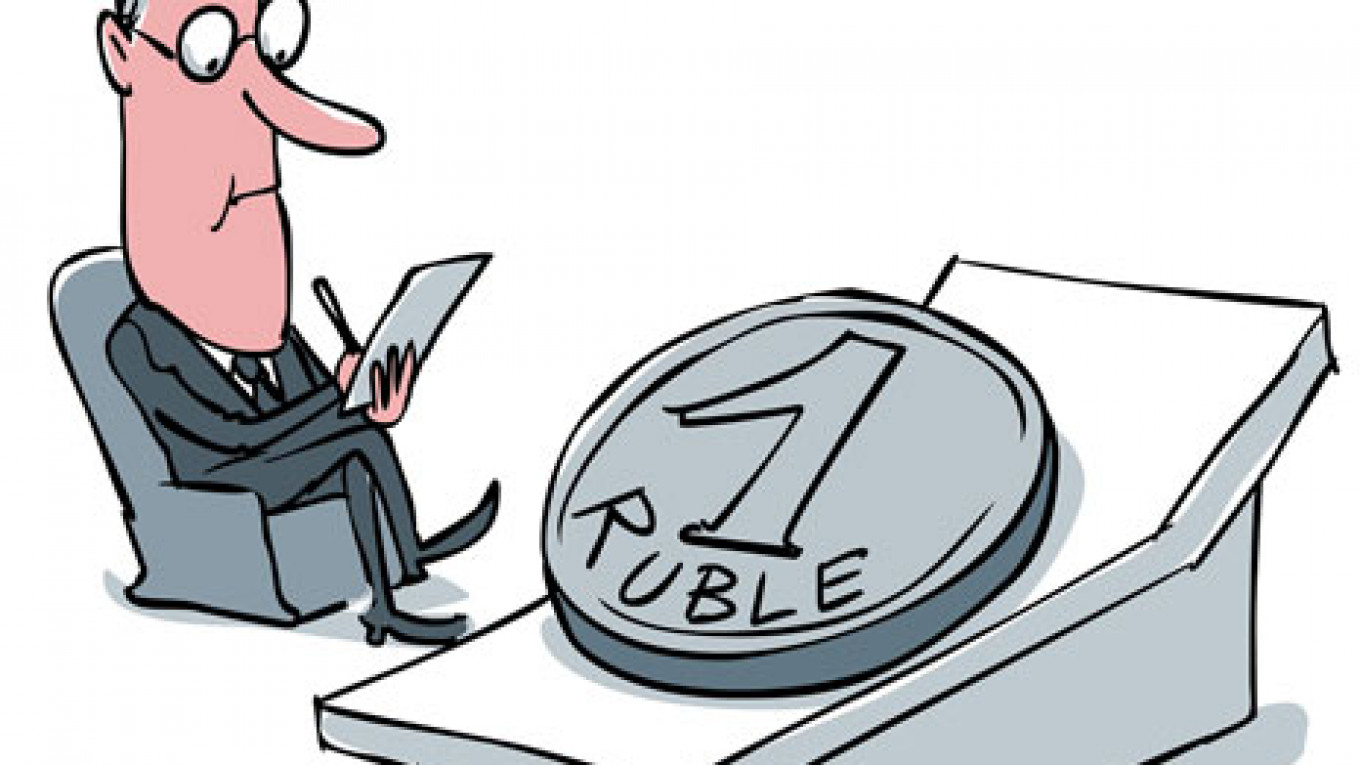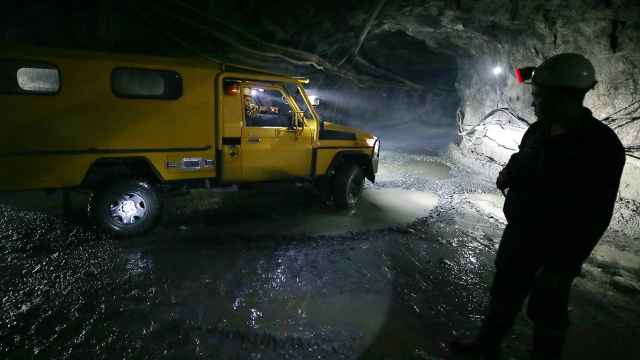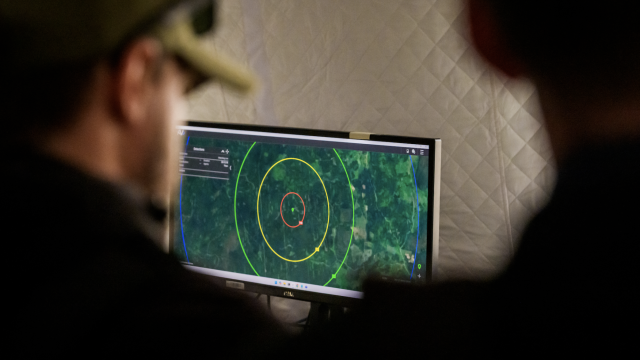Not since the financial crisis of August 1998 has Russia faced the very real possibility of a currency crisis that could seriously threaten the fundamental stability of the country's economic and political system.
Though the ruble's loss of 20 percent of its value this year falls well short of the 70 percent collapse in 1998 and is even lower — in relative terms — than the 30 percent decline experienced in 2008, there are key parallels between the 1998 crisis and the crisis developing in Russia today. Both Russia's leaders and citizens would do well to remember the lessons of August 1998 as they face the coming storm.
There is a wide range of macroeconomic forces that can influence the exchange rate through supply and demand for the national currency. Importantly, most of these forces lie outside the control of the government. The Asian financial crisis of 1997 issued a collective wakeup call to international lenders as they realized the mistake of their myopic enthusiasm for investment in developing economies.
Having awoken to the fundamental weaknesses in these economies, investors became risk averse toward developing economies — Russia included — almost overnight. Russia's access to foreign borrowing was cut off at the very same time that oil prices — the country's eternal economic crutch — were declining. Falling oil prices meant fewer dollars coming into Russia, thus strengthening the dollar against the ruble, as well as less revenue going into state coffers. The foundations of a debt crisis were set.
By 1998, years of post-Soviet economic decline, a costly war in Chechnya and unsustainable social spending had nearly bankrupted the Russian state. The government and many private firms were heavily burdened with foreign loans denominated primarily in dollars with few willing lenders remaining.
Regardless of the value of the ruble, these loans had to be repaid in dollars when they came due. Thus, the Russian government had a major interest in propping up the ruble: It would cost far more rubles to pay off these loans at 20 rubles to the dollar than it would at 6 rubles to the dollar. It was able to do so only as long as it had the currency reserves to buy up excess rubles on currency markets with dollars, thereby reducing the ruble's supply and maintaining the currency's value.
By August 1998, the country had burned through $27 billion, exhausting its foreign currency reserves until it could no longer defend the currency. This resulted in a de facto "float" that revealed the true market price of the ruble, far below the futile peg that former Russian President Boris Yeltsin's government had tried to defend.
Currency crises like the one in August 1998 are often characterized by a vicious downward spiral of self-fulfilling prophecies. As expectations rise that the government will eventually fail in its efforts to defend the currency, more and more ruble holders will convert their rubles into stabler currencies. Demand for rubles falls while demand for dollars rises, putting downward pressure on the Russian currency. Furthermore, these transactions flood the market with even more rubles that the government is forced to buy up if it hopes to maintain the currency's value.
Since nobody wants to be the last man holding rubles when the currency collapses, this spiral can exacerbate and accelerate the coming collapse. Speculative attacks only add fuel to this fire.
Though Putin's Russia in 2014 is a vastly different country than Yeltsin's Russia in 1998, the parallels between the two eras are strong enough to warrant Russians to take heed. Though the government does not have the same debt burden today, neither does it have infinite reserves.
A costly intervention in Ukraine's ongoing conflict, the costs of integrating Crimea into Russia, falling oil prices, unsustainable budget expenditures for the sake of maintaining regime support, and billions wasted defending the ruble could quickly drain the country's estimated $450 billion in reserves. By comparison, the 2008 intervention to defend the ruble cost $200 billion. Though it can hold out for much longer than it did in 1998, Russia cannot withstand falling oil prices and exchange rates forever, especially if sanctions drag on.
If Russia reaches the day when it has exhausted its reserves, it will struggle to find willing lenders, just as it struggled in 1998. But this time it won't just be due to risk aversion on the part of international lenders; sanctions on Russia's largest banks have choked off much of the country's access to international borrowing.
This reality lays the foundation for a new debt crisis that could rock the public and private sectors as Russian firms struggle to service existing debts without access to additional international borrowing. As was the case in 1998, most of those existing debts are denominated in dollars — and now in 2014 — euros. Businesses are well aware that those debts will become increasingly costly to repay as the ruble spirals downward.
And so the vicious cycle takes hold. Indebted businesses snatch up what few dollars and euros they can acquire on already-strained domestic markets, fueling the ruble's fall. Firms with large holdings in rubles exchange them for foreign currencies as a hedge against further devaluation. The ruble falls further.
Eventually, the man on the street will realize that his life savings — what little there may be — are evaporating as the ruble slides further. The self-fulfilling prophesy becomes reality as ordinary Russians struggle to meet the basic needs of their families amid rampant inflation.
Two key consequences of the August 1998 crisis are worth remembering. First, the country's economic trajectory was put in a tailspin once again, with Russians' real wages falling to their lowest level in the post-Soviet era. Russia's economy would recover only with the rebound in oil prices during the ensuing decade. There is no guarantee that Russia can count on such fortune today, and the full economic costs of Russia's current confrontation with the West remain to be seen. However they tally, they will be steep.
Second, the 1998 crisis was a watershed moment in Russia's political development. The people of Russia, beaten down by years of economic trauma and failed reforms, were ready by 1998 for anyone but Yeltsin. Russians demanded anyone who could restore order and stability to Russia's economic and political system; Russians demanded the anti-Yeltsin.
August 1998 set the stage for the rise of Vladimir Putin, the anti-Yeltsin. Should the vicious cycle of economic crisis grip Russia once again, we can only imagine what kind of "anti-Putin" could rise from the ruins.
Robert Person is an assistant professor of international relations and comparative politics at the U.S. Military Academy at West Point. The views expressed in this article do not necessarily reflect those of the U.S. Military Academy, the U.S. Army or the Department of Defense.
A Message from The Moscow Times:
Dear readers,
We are facing unprecedented challenges. Russia's Prosecutor General's Office has designated The Moscow Times as an "undesirable" organization, criminalizing our work and putting our staff at risk of prosecution. This follows our earlier unjust labeling as a "foreign agent."
These actions are direct attempts to silence independent journalism in Russia. The authorities claim our work "discredits the decisions of the Russian leadership." We see things differently: we strive to provide accurate, unbiased reporting on Russia.
We, the journalists of The Moscow Times, refuse to be silenced. But to continue our work, we need your help.
Your support, no matter how small, makes a world of difference. If you can, please support us monthly starting from just $2. It's quick to set up, and every contribution makes a significant impact.
By supporting The Moscow Times, you're defending open, independent journalism in the face of repression. Thank you for standing with us.
Remind me later.






